 | |
|  |
|
|
| |
| Supermassive Eraser Round-up, Round 2! | Jun 20, 2013 3:37 AM PDT | url |
| | |
Added 1 new A* page:Getting the shadows in the scanned version of this page to balance out right finally taught me what Photoshop's "Curves" adjustment tool is for. ;)
~~~~~~
Since I rated ten imported Japanese erasers against each other to discover the best eraser for A* in the Supermassive Eraser Round-up a week or so ago, I've got new paper, new pencils, and a whole new batch of erasers—Japanese, American, and German—and so it's time for round 2!
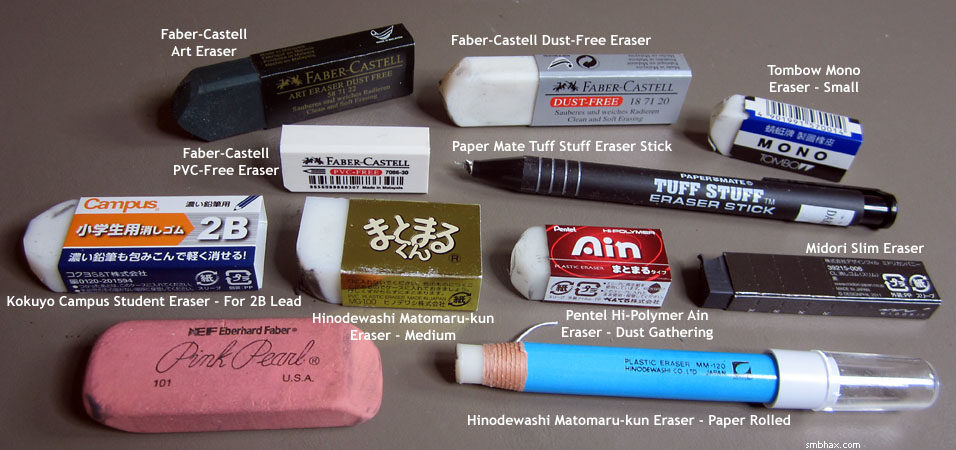
Again, the Pink Pearl in the lower left is just for scale. Oh and two big Faber-Castell erasers at the top aren't actually that long, I just couldn't get them to go back in their little paper sleeves all the way.
Last time, I was testing erasers against relatively hard H-grade Tombow Mono lead on relatively fuzzy, thick Canson Illustration Paper. This time around, unless noted otherwise, they're trying to remove darker, much softer 4B-grade Tombow Mono lead from thinner, smoother Canson Foundation Bristol.
Let's get some of the easy ones out of the way:
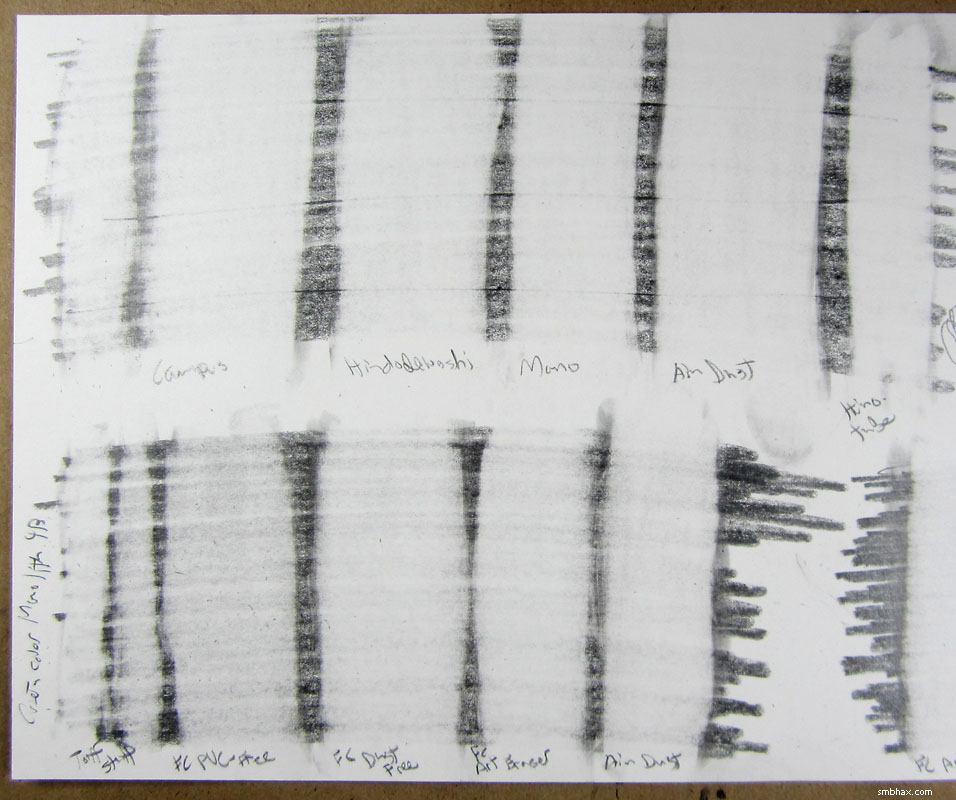
Here we see, in the lower left corner, that the Tuff Stuff and Faber-Castell PVC-Free just can't hang in terms of erasing power (that lower test they're in used a 4B-grade Cretacolor Monolith Woodless Pencil, which was overall tougher to erase, maybe because its graphite flakes off a little more readily than the Tombow Mono's, making more of a mess for erasers to deal with—otherwise I stuck with the Mono pencils, though, because they're what I'm drawing A* with).
10. Paper Mate Tuff Stuff Eraser Stick
User reviews of this thin-tipped, mechanically advanced eraser were high, but I felt fairly certain there was no way Paper Mate could make an eraser that could go toe to toe with the big boys—and boy was I right; using the Tuff Stuff is an utterly awful experience: it erasers very poorly, leaves little blobs of debris behind, and the tip wears down very, very quickly. Of course, the point is that it *has* something of a point at the tip and can thus erase tiny little details...but not very well; you'd be far better off, I think, teaming a real eraser with an eraser shield (although I can't say for sure because while I have one, I haven't bothered using it—and part of me wonders if softer erasers might not get a bit cut up against the shield's thin edges; in any case, the Tuff Stuff is still way below what it could be in terms of eraser quality).
9. Faber-Castell PVC-Free Eraser
I found this little guy at my tiny local art supply store; it was cheap and I figured why not. The "PVC-Free" label brought to mind the disastrously awful Tombow Mono NP Non-PVC Eraser, which came in dead last in the first round, and yes, this one is just as bad: erases poorly, and leaves lots of shreds. At the current level of human technology, it seems you just need that darn PVC stuff for proper erasing, because the erasers that try to get by without it are terrible.
Speaking of which:
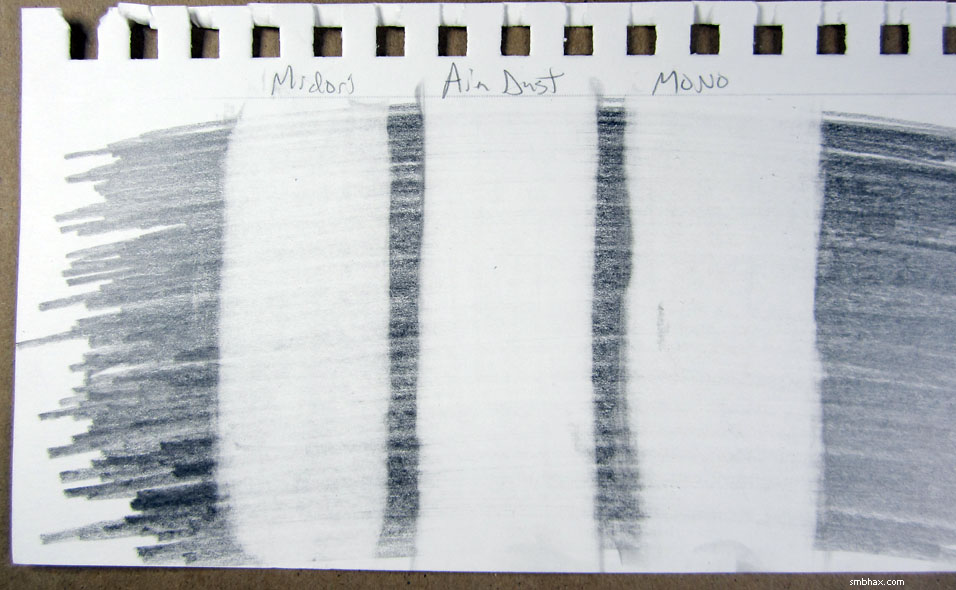
8. Midori Slim Eraser
A non-PVC eraser sporting a sleek, slender form factor, designer colors, and a sleeve with punched tear strips that peel off in handy increments as you wear down the eraser, the Midori is about as much style over function as you get in an imported block eraser: for all its cool factor, it erases poorly, and wears down very quickly; don't get this if you want to look cool while actually erasing something. I can see why Jetpens.com doesn't stock this one—I came across it at Hong Kong-based import site stationeryart.com [sic].
In that last photo we can also see that the Tombow Mono eraser is holding up pretty well against the previous round's champ, Pentel's Ain Dust-Gathering—and you can see it doing pretty well against the field in the top test of the photo before that, too. First though I'm going to knock off the one in the upper right of that photo, labeled "Hino-tube" in my illegible handwriting:
7. Hinodewashi Matomaru-kun Eraser - Paper Rolled
I tested a long, square-ended Matomaru-kun (Jetpens says "'Matomaru' means 'collects' or 'gathers'" in Japanese) in round 1, and later happened to spot this cylindrical version. It feels like it pretty much uses the same eraser material as the other Matomaru-kun erasers, which means that it is a *very* soft, very tacky eraser that really grips onto the paper—it can erase with the best of them, but it takes extra muscle power to move it across the paper. The handy form factor of this "rolled" version helps give some leverage, *but* the string-and-peel procedure needed to open up a new length of the quickly wearing tip is kind of a pain, and when you do expose that new length of tip—maybe four or five millimeters—it is so soft and tacky that it feels as though it's going to rip right off when you try to use it. Just very difficult to use, and the tip is wide enough that it can't really serve as a good spot eraser, either.
Which brings us to the other Matomaru-kun, whose test patch was labeled "Hinodewashi" in that same photo (...okay, actually "Hindodewashi," because I am that awful at writing):
6. Hinodewashi Matomaru-kun Eraser - Medium
I thought the block form of the Matomaru-kun might make it easier to use than the longer versions, and it does a bit—in particular if feels less likely to tear apart when you're straining away at it—but bringing more of its supremely tacky surface in contact with the paper also just makes it that much harder to move; trying to erase anything with the medium block is a real workout! (I can't even imagine trying to budge the larger size block. :o) In theory this can remove soft lead grades as cleanly as most of the other top erasers here, but it is not worth the significant extra effort needed to accomplish the same level of cleaning that the others can achieve with much less toil.
At this point the five remaining erasers are all pretty darn good. Eliminating the first one is easy, though, if only because you just can't get them any more and I didn't want to use mine up:
5. Tombow Mono Eraser - Small
A shockingly good eraser considering that it was discontinued years ago (and for exactly what I can't seem to discover over the internet; the most I've got is from Jetpens' description of the newer, "Non-PVC" Mono, which says that the original Mono "can no longer be imported due to US government restrictions on the material composition"; I did try looking for clues as to what this forbidden material might be—it feels like a PVC-based eraser to the touch, but is not labeled clearly yea or nay on that as the modern Japanese erasers are; the only thing I could make out on the label was the katakana for "Vietnam," which is probably where it was made); the Mono's erasing and shred-clearing power easily rivals the best modern erasers, still. I think it is just a *shade* behind them—but it's a very tough call, and I would have had to use up a lot of my sole little Mono trying to make a closer determination. Since you can't really buy the original, discontinued Mono anymore (the link above goes to its listing on stationeryart.com, where Google happened to find me a small stock of a couple dozen of the smallest size original Monos—but they were all bought out in a matter of weeks), it can't really be considered a candidate for daily-use erasing, unless you're one of those fanatic old fans (and who can blame you) who stockpiled them back in the day. I'm quite happy to have found one, and while it seems like quite a good, useful eraser, I'd rather preserve it in a spot of honor in my art supply hoard than use it up in further tests or artwork.
That leaves four candidates remaining; I did battery upon battery of tests with them, but there wasn't really all that much difference in their erasing power—they were all darn good at clearing away that 4B lead from the Bristol.
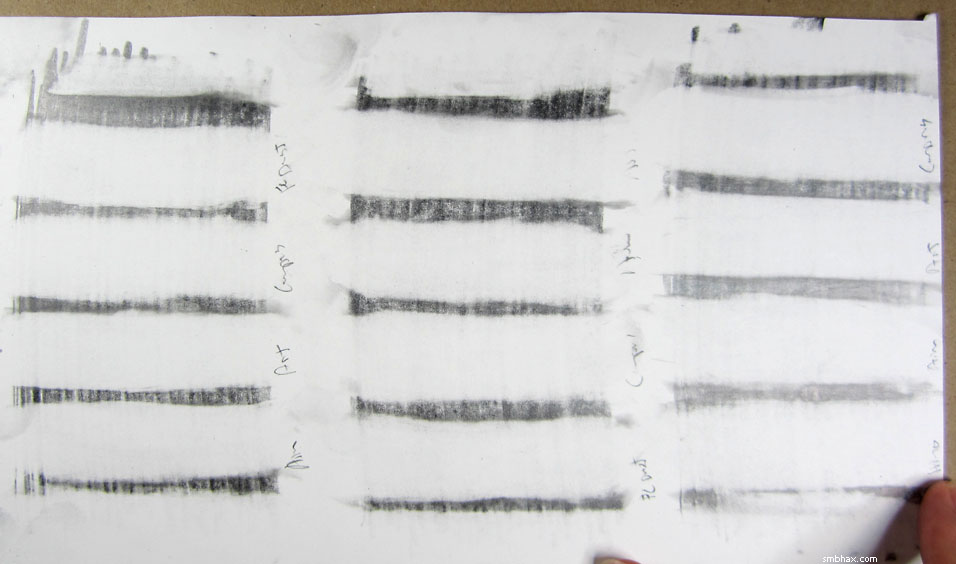
After a page or two of graphite-scrubbing I decided I could eliminate one of them that was something of a duplicate:
4. Faber-Castell Dust-Free Eraser
At my local store, Faber-Castell's Dust-Free Eraser, roughly the same big long bar form-factor as the common "Mars" eraser of Faber-Castell's bitter German rival, Staedtler (the Mars was eliminated before the first round really began :p), was cheaper than their similarly sized "Art Eraser" (see below)—and its white vinyl does seem to erase maybe a *smidge* less effectively than the Art's dark green. Still gosh-darned good at erasing soft lead, and cleaning up its own shreds into big, easily removed single rolls.
That left three erasers, but try as I might, I just could not be sure that I spotted a clear winner or loser among them in total cleaning power—so at this point I had to start considering other important factors in an eraser's effectiveness. I could think of two: durability/longevity, and smeariness. Of these two, when it comes to very soft lead like 4B, I'd been finding in drawing the recent A* pages in 4B that resistance to smearing is the most vitally important factor after overall cleanliness, because smeared graphite can be a pain pain to clean up—and sometimes just can't be cleaned completely, leaving streaks behind—and because a smeary eraser just can't be relied upon to erase fine details, or to leave clean edges. Considering the surviving erasers from that angle, the next elimination—surprising considering the results of the first round-up—was easy:
3. Pentel Hi-Polymer Ain Eraser - Dust Gathering
While the Ain Dust-Gathering reigned supreme at the end of the initial eraser round-up, against hard, light H-grade lead, I noticed even then that it was more prone than the other erasers to smearing when it hit a particularly thick patch of graphite. In H that wasn't a big concern, as it didn't happen too often and the smears could be tidied up pretty easily; when moving to soft 4B lead, though, that inclination to smear became a real drawback, as the eraser left smudges behind that just couldn't be removed, and turned any attempt at fine erasing work into a smudged, blurry area. While it was the most durable of the remaining erasers by quite a bit, its cleaning power, potentially quite high, was too unreliable on the slick 4B surface. It remains my go-to for use on harder lead grades, like H, but not for the softer stuff like 4B.
Now I was down to just two! Which would be champ? How to decide? At first I thought durability would be the telling factor this time, as the one I was trying for daily drawing eventually tore—but then the other tore in another battery of tests! But I realized I could deal with tearing, as long as the thing could be counted upon to erase soft lead without disastrous results on the paper—so again it came down to a smudge test, this one fairly clear cut in the end:
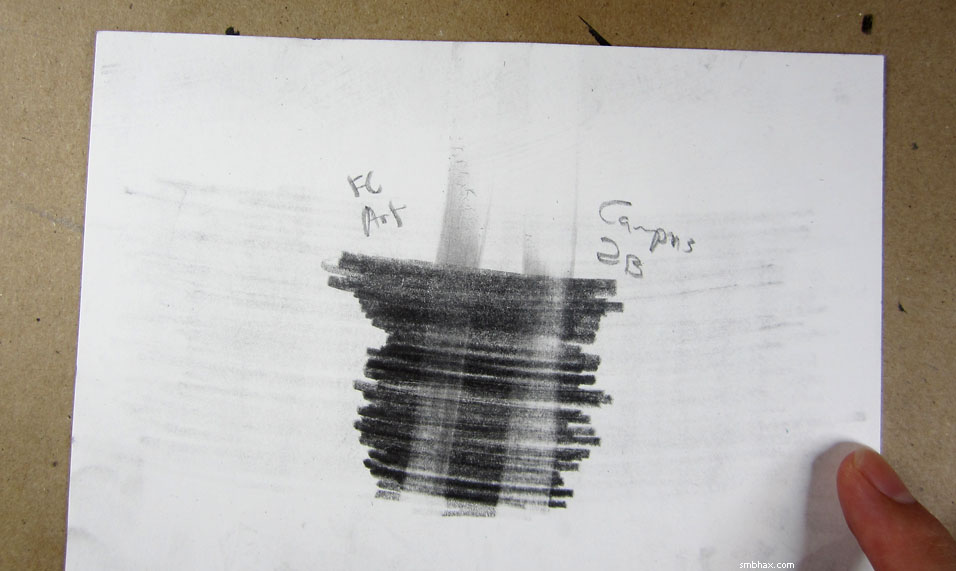
A single swipe of each across a field of heavy 4B graphite showed that one of the two, while not as smeary as the Ain Dust-Gathering, was clearly less firm of footing on the slick surface, and made a bigger mess across the page while picking up less graphite:
2. Faber-Castell Art Eraser
The Art Eraser was quite a surprise: stumbling across it by chance at the local art supply store, I thought there was no way this domestically available, German eraser could take on the imported Japanese giants—surely it would pale in comparison, as had German rival Staedtler's similarly sized "Mars" eraser. Not a bit! The curiously dark green Art Eraser beat out just about all comers when it came to clearing soft lead from smooth Bristol, and was no slouch at rolling its shavings up into easily-cleaned bunches, either. It was one of the sturdier-feeling erasers of the bunch, too, although in fact I think it is fairly soft, and eventually tore in the course of some heavy erasing drills. I can't really count this as a defect, though, as its closest competitor also tore under heavy pressure—I think it's just a necessary factor of the soft texture needed to clean at this level. As far as I'm concerned, then, the Art Eraser is the best eraser I've found in the States; and, incidentally, although it was pricier at my local small chain store than its "Dust-Free" white-colored Faber-Castell brethren, online superstore Dick Blick currently has it *cheaper* than the Dust-Free at the link above; the printing on the sleeve is slightly different, not having the "Art Eraser" title mine does, but the ID number, "58 71 22," is the same, so I'm fairly sure it's the same, excellent eraser, and at a very low price.
And so the soft-lead-erasing champion is:
1. Kokuyo Campus Student Eraser - For 2B Lead
(Update: as detailed in Round 4, the Kokuyo erasers are not phthalate-free, so I'm not using them anymore.)
The Campus 2B was second-best in my earlier eraser round-up, against hard H-grade lead, but, as the name implies, it really comes into its own when pitted against the softer "B" grades of graphite; it erases as completely as anything, and automatically gathers its shreds into easily removed long rolls, but where it ultimately pulls away from the rest of the pack is in its sure, confident grip on the page: it is much, much less prone to skidding and smearing than the other erasers in its class, meaning you can carve it into the thickest concentration of soft lead in full confidence of being able to pull away a clean, precise edge where other erasers would be able to manage little better than a smudge.
Part of what it takes to accomplish this sure-footed cleaning power is a soft consistency, and that means the Campus 2B or similar erasers, like the Faber-Castell Art Eraser or the Hinodewashi Matomaru-kuns, can potentially develop a tear or rip close to where you hold them at the tip after repeated heavy use (it took about four full, heavily erased A* pages before the 2B started to develop its first split), but just cut the tip off cleanly with a sharp knife and you're back in business (do *not* just tear off the tip and continue with the jagged torn edge left behind—that will fragment into many smaller torn sections, soon crumbling the rest of the eraser to bits—that's what happened with my first Campus and Matomaru-kun :p).
Also, the first thing to do before you even start using them is to remove the paper sleeve they come with, because the edge of the sleeve will start to cut into the leading end of the eraser once you start flexing it against the page, and then you've got the start of your first tear, and probably very quickly.
Another precaution might be to keep your fingernails in fine trim; mine are maybe a couple millimeters long now and *may* be responsible for starting the latest tearing to my new Campus 2B and Faber-Castell Art Eraser, but I'm not certain of that—with the Art Eraser in particular I think it was more likely just the pressure of the tip against the page that led to tearing on its own.
Anyhoo that's it for now with the erasers; these Campus 2Bs won't last nearly as long in daily use as the little Ain Dust-Gatherers, but for soft lead you still can't beat 'em with anything I know of. And the Ain may have competition even in the hard lead category, as Jetpens just got the Campus B/HB back in stock—the version meant for harder leads. I've got one of those shipping to me, so we'll have at least one more mini-round-up to pit that against the Ain on H-grade lead.
~~~~~
Update: The Campus B/HB is here and ready to go against the Ain Dust-Gathering! See round 3.
|
·····
|
|
|
